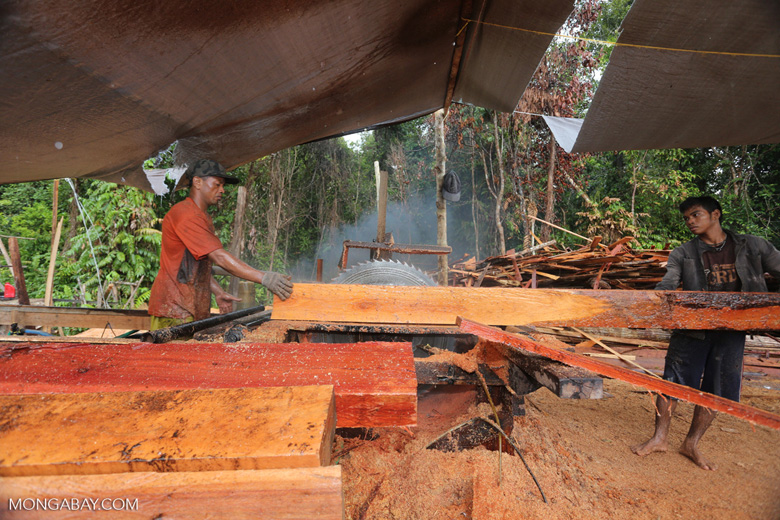The world’s tropical forests are in serious trouble, with deforestation worsening and the sixth mass extinction accelerating faster than scientists previously thought. This grim news comes more than a decade after the international community agreed on a strategy for curbing the destruction of tropical forests as part of global effort to tackle the climate crisis.
Known as REDD+ (reducing emissions from deforestation and forest degradation), the strategy sounds simple: Rich, industrialized countries would pay developing countries for preserving forests and preventing the emissions of carbon dioxide that come with destroying trees. But making REDD+ work has turned out to be anything but simple, in large part because its architects have yet to design the global carbon market that was meant to pay for it.
This means 13 years and plenty of tense negotiations after REDD+ officially debuted in the U.N. Framework Convention on Climate Change (UNFCCC) summit in 2007, in the real world, it still doesn’t exist at the scale it was conceived at.
“No, REDD has not achieved its goals!” said Frances Seymour, a leading international authority on tropical forests and a distinguished senior fellow at the World Resources Institute (WRI), on a recent Skype video call. “Because the goal is to reduce and eventually reverse tropical deforestation, and it’s clear we’re losing.”
After roughly three decades of fighting the uphill battle against deforestation, Seymour still gets visibly passionate when she talks about saving forests. She is part of a small group of tireless REDD+ advocates — scientists, conservationists, economists and other experts — who say they remain dedicated to seeing it through and that they steadfastly believe, as Seymour puts it: “The reason it hasn’t achieved its goals is we haven’t actually tried it.”
At this critical moment for forests, this two-part Mongabay series delves into the past, present and future of this controversial global strategy. We’ll look at the progress that’s been made, including recent developments that could represent something of a turning point for REDD+: the first large-scale, “results-based” funding, the conditional financial incentives seen as key to REDD+’s success, from the U.N.-REDD Programme and the World Bank; and a surge in private-sector dollars for forest conservation and reforestation projects that could mark the beginning of a significant new source of cash. We’ll also address the challenges that remain to delivering a working system at its intended scale, not least of which is the economic fallout of the coronavirus pandemic, which could potentially trip up progress just as REDD+ looked poised to gain some real ground.
While REDD+ remains divisive, its advocates offer this perspective: We have clearly not managed to protect forests without economic incentives, and sufficient donor funding from governments, NGOs and philanthropists shows no signs of materializing. We need a way to raise money to address deforestation in the world’s crucial rainforests, and the only plan we’ve got to finance forest conservation at a global scale is REDD+.
“In the economic system that we have, and that we will keep for the foreseeable future, if you don’t put a price on something, it’s free,” Arild Angelsen, an economics professor at the Norwegian University of Life Sciences and a senior associate at the Center for International Forestry Research (CIFOR), Indonesia, said in an interview. Angelsen has conducted extensive research on tropical deforestation, environmental income and REDD+. “Deforestation happens because it’s profitable for someone. There’s good money in chopping down trees, mainly to convert the land to agriculture. And the idea that REDD should change that equation by making a living tree more valuable than a dead tree — it will cost a lot of money if you really want to do that.”
By one estimate, a minimum of $150 billion a year is needed to fill the gap between current funding for nature conservation and what’s necessary. By another, we need $100 billion in additional annual investment in nature-based solutions — such as forest conservation and reforestation; restoration of wetlands and grasslands; and regenerative agriculture — to transition toward a more sustainable food and land use economy by 2030.
Meanwhile, the destruction of tropical forests worldwide increased again last year, with the loss of 3.8 million hectares (9.3 million acres) of old-growth forest, an area nearly the size of Switzerland, according to new data released by WRI’s Global Forest Watch. This makes 2019 the third worst year (after 2016 and 2017) for forest destruction since 2002. And thanks to the pandemic, 2020 could be even worse.
The gravity of the situation cannot be overstated.
We already knew we have little more than a decade to limit the warming of planet below 1.5° Celsius (2.7° Fahrenheit) from pre-industrial levels, the target of the Paris Agreement. Now, new research finds that human activity, including the destruction of forests and other habitats, is driving millions of species to extinction even faster than scientists had thought. The research points to roughly the same critical window, 10 to 15 years, for preventing the loss of entire ecosystems and, eventually, the planet’s collapse.
The world’s forests are running out of time. REDD+ is far from a silver bullet, but can it still play a role in saving them?
 A tea plantation in Cameroon. Large scale agribusiness, driven by the developed world’s hunger for palm oil, rubber, tea and other commodities is driving African deforestation. Photo by Rhett A. Butler / Mongabay
A would-be game changer
A tea plantation in Cameroon. Large scale agribusiness, driven by the developed world’s hunger for palm oil, rubber, tea and other commodities is driving African deforestation. Photo by Rhett A. Butler / Mongabay
A would-be game changer
Officially, REDD was born at the international climate talks on the island of Bali in 2007, but the idea had been evolving for more than a decade prior, as environmental NGOs and others experimented by financing projects to save isolated patches of forest. U.N.-sanctioned REDD had begun gaining traction in 2005, at that year’s talks in Montreal, when the newly formed Coalition for Rainforest Nations, led by Costa Rica and Papua New Guinea, offered to slash their emissions by saving forests, but only if developed countries rewarded them for their results. REDD became REDD+ in 2008 in Pozna, Poland, when negotiators expanded it to include sustainable forest management and reforestation.
Because of REDD+’s potential not only as a climate change mitigation strategy but also as a mechanism to, for the first time, drive significant funding into forest preservation, the international community welcomed it into the world with enthusiasm and big expectations.
“When it was launched, there was a lot of optimism that this would be a game changer,” Angelsen recalls.
But there were already signs of trouble.
From the beginning, the question of how to pay for REDD+ proved contentious, as did other issues such as Indigenous rights. The rich countries of the global north weren’t simply going to hand over the billions of dollars needed to conserve tropical forests. However, some also raised concerns about making REDD+ part of a market-based system, where industrialized nations and companies get something (carbon credits to offset some portion of their own emissions) in return for financing emissions reduction projects in developing countries.
The idea of awarding carbon credits in exchange for financing REDD+ projects caused unease for a couple of reasons. First, there were doubts about whether the carbon sequestered in forested areas could be accurately measured and the conservation of those areas effectively monitored. There were also fears that forest conservation credits would be cheap, especially when compared to credits for technical solutions, such as building renewable energy capacity, and cheap REDD+ credits would allow companies in the developed world to basically pay a little fee to continue polluting.
In January 2008, the European Commission excluded forestry credits from Europe’s Emissions Trading System, the first and still the largest emissions trading scheme in the world, because of such concerns.
Then, in 2009, REDD+ faced another setback, when the United States failed to create its own “cap and trade” system. The U.S. House passed major legislation in June that would have created such a system, but the bill died in the Senate, after the oil industry, the conservative Tea Party group, and climate deniers opposed it. A U.S. cap-and-trade scheme could have created significant demand for REDD+ credits and jump-started a global market. Instead, it paved the way for the blow that would seal REDD+’s fortunes for a decade to come. Later that year, at COP15 in Copenhagen, negotiators failed to agree on much of anything, including the terms of an international carbon market.
REDD+ continued to evolve over the years, with various agreements that added or tweaked important safeguards. These safeguards aimed to improve environmental outcomes and to ensure Indigenous peoples and other forest communities had a hand in developing policy and shared in the benefits of REDD+ efforts in their area. Still, the international community would continue to bicker and punt key decisions for years.
In 2015, REDD+ was enshrined in the Paris Agreement, under Article 5, as was the outline for a global carbon market, under Article 6. If Article 6 rings a bell that’s because negotiators failed once again, in December 2019 at COP25 in Madrid, to come to terms on the details of this piece of the agreement.
 Illegal logging sawmill in Borneo in 2015. REDD+ is intended to help to monitor and stop illegal logging of tropical forests. Photo by Rhett Butler
In lieu of large-scale REDD+, a hodgepodge of projects
Illegal logging sawmill in Borneo in 2015. REDD+ is intended to help to monitor and stop illegal logging of tropical forests. Photo by Rhett Butler
In lieu of large-scale REDD+, a hodgepodge of projects
As the initial optimism about REDD+ faded, many disappointed advocates turned their attention elsewhere, while others began work on facilitating alternative sources of financing.
“It’s exhausting to see things still under discussion, when what we need is more action,” said Juan Chang, deputy director of the U.N.’s Green Climate Fund, which launched a $500 million pilot program in 2017 to provide results-based payments to tropical forest countries and made its first payment last year. “You go to these workshops and international events, and everybody’s walking really quickly, looking very busy. And then you go to the forest, and nothing changes. People have lost connection with the reality. We think that REDD+ is a world in itself, that REDD+ is about going to meetings and having complicated philosophical discussions. At the end of the day, it’s about the forest and the people.”
Because of the failure to create a large-scale funding mechanism, REDD+ as it was originally envisioned — a global system that would pay tropical forest jurisdictions (countries or states) large sums of money for avoided forest emissions — still doesn’t exist.
“Because the fundamental and unique thing that distinguished REDD from the decades of donor funding for forests that preceded it was going to be performance-based finance, you get the money for the results, and the payment would be enough to make it worth your while,” Seymour said. One-off jurisdictional-level payments have been made here and there over the years, but most countries “have never actually had the prospect of significant and certain results-based finance for reducing forest-based emissions.”
What’s developed instead has been a hodgepodge of hundreds of individual REDD+ projects and programs — roughly 350 still ongoing — predominantly implemented by NGOs, environmental nonprofits, or for-profit project developers. Most of the funding for these projects has come from the development agencies of a few donor countries, such as Norway, Germany, the U.K. and the U.S. REDD+ projects have had varying degrees of success at reducing deforestation and benefiting forest communities in their targeted areas — examples of both failures and successes abound — but they’ve had little impact on deforestation and greenhouse gas emissions globally.
In part that’s because the countries where the projects are located lack a robust national strategy for REDD+, along with an accurate measurement of the carbon sequestered in the forest they aim to protect (commonly called a baseline), the capacity and the will to monitor protected areas and enforce regulations against deforestation, and safeguards to ensure forest communities benefit from the project rather than unintentionally suffer.
Developing and implementing all of this takes work, and without a significant “demand signal,” a sign that this hard work would pay off, most politicians have little incentive to spend time on long-term conservation goals. As a result, many tropical forest countries have taken their time developing national REDD+ strategies and working out the details of implementation, and the first large-scale, results-based payments at the national or subnational level have only just begun to materialize.
 Peru s Tambopata forests are home to many plants and animals, like this night monkey (genus Aotus). Photo taken in Tambopata National Reserve by Rhett A. Butler.
New development #1: Money
Peru s Tambopata forests are home to many plants and animals, like this night monkey (genus Aotus). Photo taken in Tambopata National Reserve by Rhett A. Butler.
New development #1: Money
Eighteen countries have qualified for result-based payments from the World Bank’s $900 million Carbon Fund. Chile, the Democratic Republic of Congo, Ghana and Mozambique have already signed agreements with the fund, a five-year facility designed to close in December 2025. The other 14 are expected to sign by the upcoming November deadline.
In all, these payments will reward efforts to avoid deforestation of an area roughly half the size of India.
“As far as we’re aware, this [World Bank program] is largest jurisdictional-scale REDD+ program operational in the world,” Simon Whitehouse, senior financial officer at the World Bank’s Carbon Finance Unit, said in an interview. “And the countries had to jump through quite a few hoops to qualify. In addition to all of the technical requirements, they have to create a benefit sharing plan describing how the benefits will be shared with the local communities in the forest areas.”
Meanwhile, 14 countries have submitted national strategies to the U.N., and proposals from four — Brazil, Ecuador, Chile and Paraguay — have been approved for results-based payments through the Green Climate Fund’s $500 million pilot program. Chang says he expects several more to be approved for this funding.
The first recipient, Brazil, received $96 million last year for reducing its deforestation rates in 2014 and 2015. The situation for forests in Brazil has deteriorated significantly since then. Not only have some forestry experts and conservation groups accused Brazil’s government of playing fast and loose with its baselines, which determine how reductions are calculated, deforestation in the Brazilian Amazon, both legal and illegal, has spiked in the past 14 months under the pro-development policies of President Jair Bolsonaro.
This is one of the central criticisms of REDD+: that the emissions reductions a country receives payments for might not be permanent.
According to Chang, Brazil was paid for emissions reductions that represented only 2% of the total reduction the country achieved during the relevant time period, leaving a buffer of 98%. The use of buffers has developed as a way to deal with the problem of reversals — when deforestation begins to rise in the years after REDD+ payments are made.
Chang also points out that people often misunderstand the concept of reversals. If Brazil had not taken the measures that led to less deforestation and fewer emissions in 2014 and 2015, the emissions released those years would have been in addition to subsequent years.
“It would have been worse,” he said.
Chang is keeping a close eye on Brazil, and when he describes satellite images of the clear-cutting taking place in protected areas there, largely to make way for agriculture, there is sadness in his voice. “It’s terrible, it’s terrible,” he said. However, he says he remains committed to the idea of trial and error, even as it’s clear he’s frustrated at the slow pace of change. “We will never get the perfect system running, there will always be concerns. But we have been discussing this for more than 10 years. We have to stop analyzing and start doing. The worst thing that can happen is to not do anything.”
Banner image: Sumatra s remaining forests are home to highly threatened animals found nowhere else, like the critically endangered Sumatran tiger (Panthera tigris sumatrae). Photo courtesy of ZSL.





